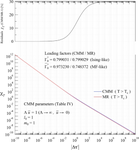Crossover Master Model of the Equation-of-State for a Simple Fluid: Critical Universality.
Abstract
We present a new extended parametric equation-of-state model for thermodynamic properties and the correlation length for a simple fluid near its liquid–gas critical point. The model involves 16 universal parameters to perfectly match 10 leading universal amplitudes of the asymptotic Ising-like limit of the critical-to-classical crossover functions calculated by Garrabos and Bervillier [Phys. Rev. E 74,021113 (2006)] from the massive renormalization scheme. The universal values of 8 Ising-like amplitude combinations are then matched exactly. The closure of the construction of parameters is determined after a careful analysis of the intrinsic limitation of parametric equations to describe the universal features at the first order of the confluent corrections-to-scaling. In the asymptotic mean-field limit, the crossover master model also reproduces the mean-field amplitude combinations except for the susceptibility case. The new model is compared with the crossover parametric model previously developed by Agayan et. al [Phys. Rev. E 64, 02615 (2001)]. The residuals from comparison with the mean crossover functions of Garrabos and Bervillier are reported to define the application range of the crossover master model to any simple fluid for which the generalized critical coordinates of the liquid–gas critical point are known.


 求助内容:
求助内容: 应助结果提醒方式:
应助结果提醒方式:


